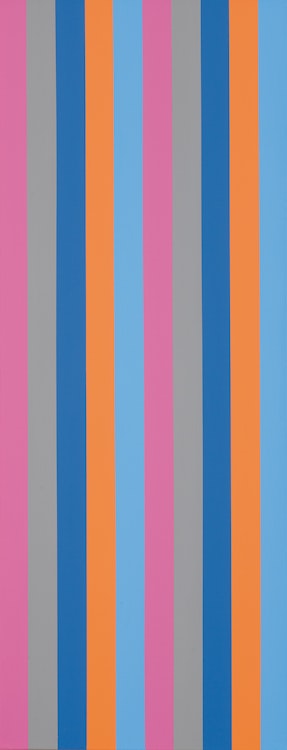Bi-sériel rose, 1968 by Guido Molinari

Guido Molinari
Bi-sériel rose, 1968
acrylic on canvas
signed and dated 1968 on the reverse; titled to a gallery label on the reverse
51 x 19.5 ins ( 129.5 x 49.5 cms )
Auction Estimate: $70,000.00 - $90,000.00
Price Realized $102,000.00
Sale date: June 8th 2023
Galerie Jolliet, Place Royale, Quebec
Dr. Jean-René Paquet, Quebec
Private Collection, Quebec
Molinari’s rigorously organized canvases require our close, even literal, attention. Both geometrically regular and chromatically complex, they work optically, corporeally, and intellectually. “Bi-sériel” rose clearly announces its key colour and organizing principle. We see two series of five colour bands; from left to right, rose, grey, darker blue, orange, and lighter blue. Because his individual colours work together (the orange and darker blue as complementary colours, for example), however, in addition to isolated stripes, they stand out as blocks in what remains a repeated sequence with variations. Individual colour columns repeat, but so do pairs of colours. The painting does not allow us to rest optically, nor does it have a stable centre (impossible with ten colour bars, unless one pairs two in the middle, as Molinari does here, leaving four symmetrical flanking columns on the left and right). Instead, our eyes and our bodies (because the painting is vertical and at a human viewer’s scale) are moved by the colour bands. We take part in a chromatic and intellectual game whose conventions are established by the painting. The game is complex but not infinite: the sequence is also clearly bounded by the fame, guaranteeing that the left edge (rose) differs from that at the right (light blue).
While “Bi-sériel rose” is primarily a painting to be taken on its own optical terms, Molinari‒akin to many abstract artists‒responded to the ambient world and encouraged his canvases to reverberate well beyond the frame. The sériels from this period, for example, were inspired by and closely cognate with his interests in the modern classical music of Schönberg and Webern.
We extend our thanks to Mark A. Cheetham, a freelance writer and curator and a professor of art history at the University of Toronto for contributing the preceding essay. He is author of “Abstract Art Against Autonomy: Infection, Resistance, and Cure since the ‘60s” (Cambridge University Press).
Share this item with your friends
Guido Molinari
(1933 - 2004) Les Plasticiens
Guido Molinari was born in Montreal in 1933. He studied briefly at the School of Design at the Montreal Museum of Fine Arts (1950-51), and began making drawings and paintings combining automatic methods with a disciplined approach. He was a leader in the development of a rigorous colour abstraction movement in Montreal. Characteristic of his paintings in the 1960s were vertical, hard-edged bands of colour. Pictorial space in these paintings was created by the spectator’s perception of the shifting and mixing of colours.
In 1956 Molinari was a founding member of the Association des Artistes Non-Figuratifs de Montreal. He exhibited at the Biennale in Venice in 1968, where he was awarded the David E. Bright Foundation prize. In 1977 he participated in the Paris Biennale, and in 1980 he was awarded the Paul-Emile Borduas Prize by the Quebec government. Molinari, who taught at Concordia University until 1997, exerted a powerful influence on younger artists, through his teaching, his theoretical writing and his opinions, firmly held and strongly stated.

